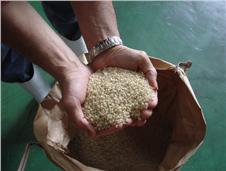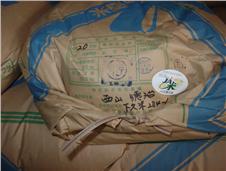 Of all the problems the sake industry faces – sake has dropped to eight percent of all alcohol consumed in Japan – a shortage of sake rice is not one that they need at this point in time. But it is one they must now deal with.
Of all the problems the sake industry faces – sake has dropped to eight percent of all alcohol consumed in Japan – a shortage of sake rice is not one that they need at this point in time. But it is one they must now deal with.
Several brewers I have spoken with have prefaced their comments about the coming year with,” If we can get the rice. But I think we will be OK.”
As most readers surely remember, sake rice is different from table rice in many ways, including size, higher starch content, lower fat/protein content, and a physical structure that places the starch in the center. That last point allows producers to mill it more and more, thereby grinding away more of the outside and remove more fat and protein, leaving only the starch behind. And sake rice costs much more too – as much as two to three times more than some table rice.
Table rice can, in fact, be used to make sake. But premium sake can be much more easily made to be wonderful when sake rice is used. Actually, perhaps 75 percent of all sake is not made using sake rice, but instead using table rice. Still, sake rice is indispensable to making great sake for sure. And sake rice is an official and separate classification, not just a nickname.
But recently, the government has been trying to reduce the number of fields on which rice is grown in an effort to stabilize the price of table rice on the market. As a part of that policy they have thrown sake rice in with table rice in terms support and subsidies for things like fertilizer and insecticides.
 While that is all fine and good, the real truth of it all is that yields for table rice are much higher than sake rice. And if a farmer is going to get no more help on sake rice than table rice, there is a lot more money to be made on rice with higher yields per field. As such, most farmers then go for the most economically sound decision for themselves.
While that is all fine and good, the real truth of it all is that yields for table rice are much higher than sake rice. And if a farmer is going to get no more help on sake rice than table rice, there is a lot more money to be made on rice with higher yields per field. As such, most farmers then go for the most economically sound decision for themselves.
Certainly there are those that grow sake rice by direct, mutually agreed upon contracts. But the majority of it goes through the standard channels of agricultural co-ops.
So in the end, brewers are running into shortages of Yamada Nishiki and other sake rice types as a direct result of these policies. Note, too, that this goes against the current efforts of at least three government ministries that are trying hard to increase exports of sake around the world. Apparently, these policies are being reviewed in search of a solution.
Rice, inspected, bought through a co-op
As one concrete example, I ran into the toji of a kura from Yamaguchi Prefecture, the makers of Kahori-tsuru at a recent industry tasting. They, and another brewer down there whose sake I like, use a sake rice called Saito no Shizuku (“Droplets of the Western City”) in some of their products. I am fond of it, and struck up a conversation with him that began with me expressing as much.
“Yeah, I like it too, and I like using it,” be started off, “but I can’t hardly get the stuff!” He continued to explain that, as great as it is to have a local sake rice that supports local economy and regionality, it was like pulling teeth to get a farmer to grow it.
“They have choices, of course, about what they grow. And the market price for this particular rice is the same as that for Gohyakumangoku (a popular eating rice), but the yields for Saito no Shizuku are significantly less, you see.”
Again; we can surely understand the rice producer’s point of view as well. But it continues.
“But then, ‘course, there is the sake rice Yamada Nishiki. The yields for that are the same as Saito no Shizuku, but Yamada commands a much higher rice. So yeah, they’ll grow that. But not my Saito no Shizuku,” he lamented.
“Wow,” I commented. “I did not know that.”
“Yeah, neither did I!” he replied. “I realized I know far too little about how these things work, how they change, and how they will affect me.”
That last line is the one that amazed me. The system is complex and constantly changes, and the motivations of the players change along with that. I am sure that everyone is doing what they feel is best for the greater good. But it is opaque enough to adversely affect sake brewers unexpectedly and directly.
~~~~~~~~~~~~~~~~~~~~~~~~~~~~~~~~~~~~~~~~~~~~~~~~~~~~~~~~~~~~~
Sake Professional Course in Japan
January 20 to 24, 2014
The 2014 Sake Professional Course in Japan will be held from Monday, January 20 to Friday, January 24, 2014. This is it – the most comprehensive and intense sake educational program on the planet. Three days of class and tastings, sake pubs and izakaya at night, and two full days of sake brewery visits. No sake stone remains left unturned!
Again – this is it! This is the course that started it all 11 years ago, for which I had a whopping three people the first year. Thanks to everyone’s support and interest in sake, it is still the most interesting way to learn about sake in existence. Study during the day, drink sake at night, visit breweries as well. Meet owners and toji, taste sake at the breweries, immerse yourself in sake in every sense of the word – and get certified!
The cost for the course is JPY 180,000 (about US$1800) and includes five days of instruction, sake and evening meals with sake. Lodging and transportation are not included. Please learn more here , or by emailing me directly.





